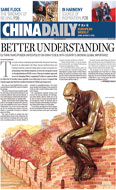Heritage
Ancient jade still has magic to enthrall
Updated: 2011-05-04 08:01
By Qin Zhongwei (China Daily)

The Chinese have a special affection for yu, or jade in English, that foreigners cannot match. A jade exhibition at Beijing Art Museum traces this love back to its origin at the beginning of Chinese civilization.
Displaying 79 sets of jade relics borrowed from Liangzhu Culture Museum in Hangzhou, Zhejiang province, the exhibition introduces Liangzhu culture, a late Neolithic (or New Stone Age) culture in the Yangtze River Delta, southeast China. The most remarkable aspects of this exhibition are the large number and the high quality of the carved jade that has survived.
Liangzhu artifacts were first excavated from Hangzhou suburbs in 1931, and later at other places in northern Zhejiang province and southern coastal areas of Jiangsu province. The culture, which can be dated to 5,300-4,300 BC, extended throughout the Yangtze River Delta. As there was no system of writing and no records remain, the high number and outstanding quality of jades found in the tombs prompted archaeologists to assume that Liangzhu culture placed great value on the stone.
The display includes jade artifacts in a wide range of shapes, such as jade bi, jade axes, jade cong, jade bracelets and jade ornaments. As well as being used as polished accessories for rich nobles, these pieces were also used in important ceremonies and religious rituals.
For example, the most prominent and representative ones are bi and cong jades. The bi is a circular ring, with a hole in the center, which was used to worship heaven, while the cong is an elongated square tube, which is thought to have been used for worshipping the earth.
Due to its origin in tremolite rock and the effects of water-based fluids at the sites, most excavated jades look milky white rather than pure and clear, according to Zhang Shuwei, director of the museum.
One piece of hollowed-out decorative plaque inspired the team of foreign architects, who designed the Bird's Nest, or the National Stadium, Zhang said.
"As they had no idea about Chinese culture when they began to design the stadium, their assistant found a series of Chinese pictures for them to look through, and it was the picture of this jade piece that inspired the nest theme and the steel frame," he told METRO.
Even more amazing are the delicately carved man and animal motifs on the jade objects. A bracelet on display has the oldest Chinese dragon totem ever found, according to Mu Zhao'na, a jade expert at the museum.
According to Mu, the motifs are astounding as there were no advanced tools in those times, and even today's craftsmen using the most technologically advanced machinery would find them difficult to reproduce.
"Although many questions about the jade remain unanswered, that may explain why jade still enthralls people today," Zhang said.
The museum is in the grounds of Wanshou Temple, or Temple of Longevity, which itself is also a place worth visiting. First built in the Tang Dynasty (618-907) and then rebuilt in 1577 during the Wanli era of the Ming Dynasty (1368-1644) to store Chinese Buddhist scriptures, the temple was a celebration site for the imperial families of the Ming and Qing dynasties. Emperor Qianlong even built a grand Buddhist hall for his mother's birthday, which gave the temple its current name.
The exhibition will run until June 12.
China Daily
E-paper

Head on
Chinese household care goods producers eye big cities, once stronghold of multinational players
Carving out a spot
Back onto center stage
The Chinese recipe
Specials

British Royal Wedding
Full coverage of the royal wedding of Prince William and Kate Middleton in London. Best wishes

The final frontier
Xinjiang is a mysterious land of extremes that never falls to fascinate.

Bridging the gap
Tsinghua University attracts a cohort of foreign students wanting to come to China.
